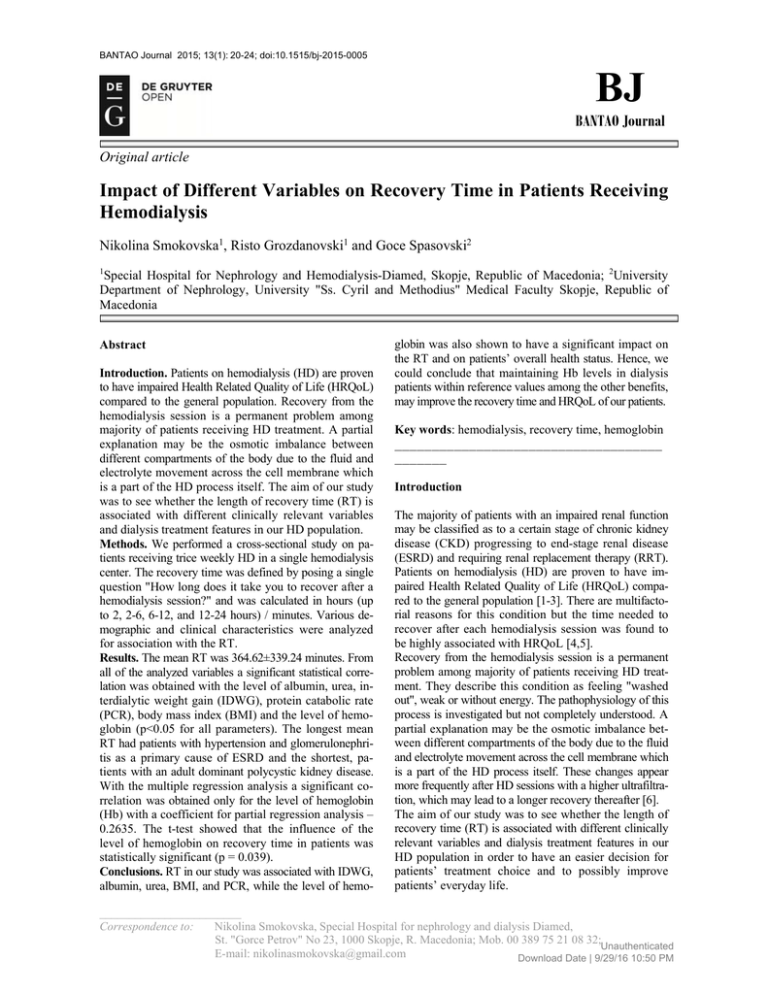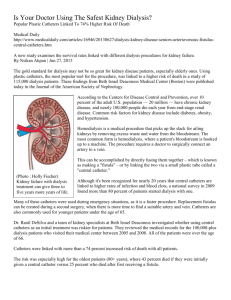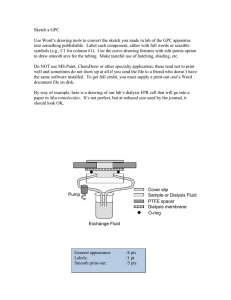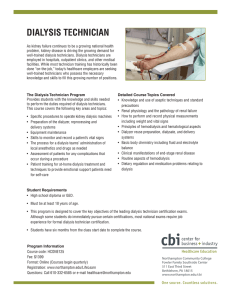Impact of Different Variables on Recovery Time in Patients
advertisement

BANTAO Journal 2015; 13(1): 20-24; doi:10.1515/bj-2015-0005 BJ BANTAO Journal Original article Impact of Different Variables on Recovery Time in Patients Receiving Hemodialysis Nikolina Smokovska1, Risto Grozdanovski1 and Goce Spasovski2 1 Special Hospital for Nephrology and Hemodialysis-Diamed, Skopje, Republic of Macedonia; 2University Department of Nephrology, University "Ss. Cyril and Methodius" Medical Faculty Skopje, Republic of Macedonia Abstract Introduction. Patients on hemodialysis (HD) are proven to have impaired Health Related Quality of Life (HRQoL) compared to the general population. Recovery from the hemodialysis session is a permanent problem among majority of patients receiving HD treatment. A partial explanation may be the osmotic imbalance between different compartments of the body due to the fluid and electrolyte movement across the cell membrane which is a part of the HD process itself. The aim of our study was to see whether the length of recovery time (RT) is associated with different clinically relevant variables and dialysis treatment features in our HD population. Methods. We performed a cross-sectional study on patients receiving trice weekly HD in a single hemodialysis center. The recovery time was defined by posing a single question "How long does it take you to recover after a hemodialysis session?" and was calculated in hours (up to 2, 2-6, 6-12, and 12-24 hours) / minutes. Various demographic and clinical characteristics were analyzed for association with the RT. Results. The mean RT was 364.62±339.24 minutes. From all of the analyzed variables a significant statistical correlation was obtained with the level of albumin, urea, interdialytic weight gain (IDWG), protein catabolic rate (PCR), body mass index (BMI) and the level of hemoglobin (p<0.05 for all parameters). The longest mean RT had patients with hypertension and glomerulonephritis as a primary cause of ESRD and the shortest, patients with an adult dominant polycystic kidney disease. With the multiple regression analysis a significant correlation was obtained only for the level of hemoglobin (Hb) with a coefficient for partial regression analysis – 0.2635. The t-test showed that the influence of the level of hemoglobin on recovery time in patients was statistically significant (p = 0.039). Conclusions. RT in our study was associated with IDWG, albumin, urea, BMI, and PCR, while the level of hemo- globin was also shown to have a significant impact on the RT and on patients’ overall health status. Hence, we could conclude that maintaining Hb levels in dialysis patients within reference values among the other benefits, may improve the recovery time and HRQoL of our patients. Key words: hemodialysis, recovery time, hemoglobin ____________________________________ _______ Introduction The majority of patients with an impaired renal function may be classified as to a certain stage of chronic kidney disease (CKD) progressing to end-stage renal disease (ESRD) and requiring renal replacement therapy (RRT). Patients on hemodialysis (HD) are proven to have impaired Health Related Quality of Life (HRQoL) compared to the general population [1-3]. There are multifactorial reasons for this condition but the time needed to recover after each hemodialysis session was found to be highly associated with HRQoL [4,5]. Recovery from the hemodialysis session is a permanent problem among majority of patients receiving HD treatment. They describe this condition as feeling "washed out", weak or without energy. The pathophysiology of this process is investigated but not completely understood. A partial explanation may be the osmotic imbalance between different compartments of the body due to the fluid and electrolyte movement across the cell membrane which is a part of the HD process itself. These changes appear more frequently after HD sessions with a higher ultrafiltration, which may lead to a longer recovery thereafter [6]. The aim of our study was to see whether the length of recovery time (RT) is associated with different clinically relevant variables and dialysis treatment features in our HD population in order to have an easier decision for patients’ treatment choice and to possibly improve patients’ everyday life. ________________________ Correspondence to: Nikolina Smokovska, Special Hospital for nephrology and dialysis Diamed, St. "Gorce Petrov" No 23, 1000 Skopje, R. Macedonia; Mob. 00 389 75 21 08 32;Unauthenticated E-mail: nikolinasmokovska@gmail.com Download Date | 9/29/16 10:50 PM 21 N. Smokovska et al. Material and methods We performed a cross-sectional study of our patients receiving trice weekly HD in the Special Hospital for Nephrology and Hemodialysis-Diamed, Skopje, R. Macedonia. Exclusion criteria were: diagnosis of dementia, intellectual impairment, less than one year dialysis duration, and clinical instability requiring hospital admission. After inclusion into the study, all patients were assessed for the recovery time after dialysis. The recovery time was defined by posing the question "How long does it take you to recover after a hemodialysis session?" The patients were asked in their native language, Macedonian or Albanian, excluding the language barrier. This question is proven to be a reliable assessment tool for HRQoL in HD patients [4]. The recovery time was calculated using the methods of Lindsay et al. [4]. Answers were obtained in hours (up to 2, 2-6, 6-12, and 12-24 hours). Afterwards they were converted and calculated in minutes. Then we collected patients’ different demographic and clinical characteristics. This included age, gender, elapsed time on hemodialysis and duration of hemodialysis session, interdialytic weight gain (IDWG), biochemical parameters (urea, creatinine, albumin, hemoglobin, triglyceride, cholesterol, phosphate, calcium etc.), eKT/V. The Charlson’s Comorbidity Score (CCS) was used since it included reviewing the patients’ recovery time for each of the co-morbidities (congestive heart failure, diabetes mellitus, periphery artery disease, coronary artery disease, chronic obstructive pulmonary disease, malignancies and liver disease) [7]. Within the statistical analysis all continuous data were expressed as mean±SD and proportions for categorical variables. Spearman’s correlation coefficient was used to assess the association between the recovery time and each separate variable. Univariate linear regression was performed with the recovery time as a dependent variable and all other variables. Afterwards, multivariate regression analysis was performed from the variables that significantly correlated within the univariate analysis. Variables with P value less than 0.05 were considered significant. Results Patients included in the study had been on dialysis for at least 1 year, and were up to 22 years old, with an average of 6.5 years. The youngest patient was 35 years of age, and the oldest 83 (average of 59.04±9.72 years). HD frequency was thrice-weekly with individualized sessions from 3.5 to 5 hours (average 4.22 hours) targeting desired eKT/V >1.2 [8]. We delivered a screening questionnaire to a total of 108 patients treated in our HD center for the purpose of this study. The answers were considered successful in 78 patients, i.e. 72.2% response rate (not including patients who were intellectually impaired, not willing to participate, or had to be hospitalized) and were incluTable 1. Characteristics of patients (n=78) Age, years 59.04 ± 9.7 Dialysis age, years 6.55± 6.0 Sex (M/F) 51 / 27 Dialysis session, hours 4.22 ± 0.27 Primary cause of ESRD - HTA nephropathy 20 - Glomerulonephritis 21 - Diabetic nephropathy 10 - ADPKD 9 - Obstructive nephropathy 12 - Sy Alport 1 - Unknown 5 Body mass index 27.08 ± 4.8 Albumin (mmol/L) 40.15 ± 2.7 Creatinine (µmol/L) 446.64 ±466.8 Urea (mmol/L) 31.8 ± 24.9 eKt/V 1.35 ± 0.28 TG (mmol/L) 1.93 ± 1.2 Cholesterol (mmol/L) 4.03 ± 0.9 Calcium (mmol/L) 2.12 ± 0.2 Phosphorus (mmol/L) 1.27 ±0.39 Hb (mmol/L) 121 ± 13.5 IDWG (L) 2.17 ± 0.73 PCR 0.96 ± 0.22 CCS 2.04± 1.32 Data are expressed as mean±SD. ESDR=end-stage renal disease; HTA=hypertension; ADPKD=adult dominant polycystic kidney disease; eKt/V=equilibrated Kt/V; TG=triglycerides; Hb=hemoglobin; IDWG=interdialytic weight gain (L); PCR=protein catabolic rate; CCS= Charlson’s comorbidity score. ded for analysis. Their demographic, clinical and laboratory characteristics are shown in Table 1. The mean RT was 364.62±339.24 min. Majority of patients (n=34) reported RT between 2-6 hours, and only Table 2. Correlations among time of recovery after hemodialysis and different variables Spearman Independent correlation p Value variables coefficient Age 0.128 0.131 Dialysis age - 0.147 0.1 Dialysis session - 0.191 0.095 Body mass index 0.226 0.023 Albumin - 0.457 0.0003 Creatinine - 0.002 0.433 Urea - 0.214 0.03 eKt/V 0.148 0.099 TG 0.05 0.334 Cholesterol - 0.052 0.323 Calcium - 0.039 0.367 Phosphorus - 0.039 0.367 Hb - 0.457 0.00001 IDWG - 0.265 0.019 PCR - 0.254 0.012 CCS 0.105 0.180 ESDR=end-stage renal disease; HTA=hypertension; ADPKD =adult dominant polycystic kidney disease; AKI=acute kidney injury; eKt/V=equilibrated Kt/V; TG=triglycerides; Unauthenticated Download Date | 9/29/16 10:50 PM 22 Recovery time in dialysis patients Hb=hemoglobin; IDWG=interdialytic weight gain (L); PCR= protein catabolic rate; CCS=Charlson’s Comorbidity Score. 13 patients had recovery time more than 12 hours. The mean RT for males was significantly shorter 311.76±300.5 compared to females 464.44±389.1 min. The correlation matrix between different variables is presented in table 2. From all of the analyzed variables a significant statistical correlation with the recovery time had the level of albumin (p=0.0003), urea (p=0.03); IDWG (p=0.019), PCR (p=0.012), BMI (p=0.023) and the level of hemoglobin (p=0.00001).The longest mean RT had patients with unknown etiology as a primary cause of ESRD and it was 564±341 min. Patients who had an adult dominant polycystic kidney disease (ADPCD) had the shortest RT, 160 min ±60 min. (Table 3). We did a comparison of the RT between each of the groups against all others and found that patients with ADPKD had the shortest RT. Table 3. Comparison of RT between each particular groups vs all others Primary cause of ESRD RT (min.) ± SD p value (n=78) - HTA nephropathy 420±355.23 0.2 - Glomerulonephritis 405.71±389.73 0.26 - Diabetic nephropathy 294±305.22 0.24 - ADPKD 160±60 0.03 - Obstructive nephropathy 340±350.17 0.39 - Unknown 564±341 0.09 Data are expressed as means ±SD. ADPKD=adult dominant polycystic kidney disease Univariate linear regression was performed with the recovery time as a dependent variable associated with each of the normally distributed variables. The RT showed a significant predictability with the variables which had a correlation with the Spearman’s correlation coefficient (Table 4). Table 4. Univariate linear regression analysis for the association of RT and clinical and biochemical variables Independent variables r p value Age - 0.055 0.315 Dialysis age - 0.128 0.132 Dialysis session - 0.155 0.088 Body mass Index 0.275 0.008 Albumin - 0.353 0.0008 Creatinine - 0.07 0.37 Urea - 0.309 0.003 eKt/V 0.111 0.167 TG 0.036 0.376 Cholesterol - 0.038 0.372 Calcium 0.065 0.287 Phosphorus - 0.175 0.063 Hb - 0.412 0.0001 IDWG - 0.218 0.028 PCR - 0.241 0.017 CCS 0.052 0.327 eKt/V = equilibrated Kt/V; TG = triglycerides; Hb = hemoglobin; IDWG = interdialytic weight gain (L); PCR = protein catabolic rate; CCS = Charlson’s Comorbidity Score. When the multiple regression analysis with the RT and all other patients’ independent variables was performed, the multiple regression coefficient (R) was 0.559. Determination coefficient (R²) was 0.313 showing that all independent variables as one influence the variability of the recovery time with 31.3%, while 68.7% of the influence is coming from other factors. Additionally, the coefficient of multiple correlation based on F-distribution showed that the influence of the predictable group of variables on the recovery time (dependent variable) was statistically significant (p=0.027). When analyzing all the individual variables, a significant correlation was obtained only for the level of hemoglobin (Hb) with a coefficient for partial regression analysis - 0.2635. The t-test showed that the influence of the level of hemoglobin on recovery time in patients was statistically significant (p=0.039). The influence of other predicative variables of interest on the recovery time was not statistically significant (Table 5). Table 5. Multiple regression analysis for the association of rt and clinical and biochemical variables R = 0,559 R2 = 0,313 Independent variables p = 0.027755 F = 2.47 Beta t - test p - level Urea -0.051 -0.395 0.694 Albumin -0.182 -1.364 0.177 IDWG -0.206 -1.652 0.104 Hb -0.263 -2.100 0.039* PCR -0.080 -0.668 0.506 BMI 0.160 1.437 0.156 Gender 0.098 0.737 0.464 Age 0.160 1.197 0.236 eKT/V 0.057 0.443 0.659 Phosphorus 0.149 1.196 0.236 TG 0.086 0.684 0.496 Cholesterol -0.116 -0.812 0.420 Calcium 0.063 0.550 0.584 Creatinine 0.072 0.579 0.565 * statistical significance Discussion There were several studies evaluating the possible associations between various demographic, laboratory and clinical variables with RT [4,8-10]. Lindsay et al. pointed out that not only the test-retest consistency of the question measuring RT proved to be stable over time, but at the same time it correlated well with the HRQoL measurements [4]. In our study we investigated whether recovery time is influenced by different characteristics related to patients’ characteristics or within the HD process itself. This might be important in treatment modifying decision about the hemodialysis regimen for sole purpose of improving patients’ well-being despite their burden of ESRD. Unexpectedly, the reported RT was not affected by patients’ age, years spent on HD or the length of the HD session previously observed in the work of Kwabena et al. [9]. Our findings suggest that RT may be independent Unauthenticated Download Date | 9/29/16 10:50 PM 23 N. Smokovska et al. from these variables. However, there is no clear explanation why it happens. It may be partially explained by the wide range of patients’ age and years spent on HD. Surprisingly, there was no correlation between the recovery time and the adequacy of HD. The explanation for this might be that eKT/V is a number which is highly sensitive to change based on the technician’s skill to pin point the exact moment for blood extraction and varying session by session because of many reasons that are not considered of interest for our study aim. Maurizio et al. [10] showed no association between the recovery time and different laboratory variables. In our study, from all investigated laboratory variables (creatinine, albumin, urea, TG, cholesterol, Ca, P, Hb) only the level of albumin (p=0.0003), urea (p=0.03) and hemoglobin (p<0.001) showed a significant but inverse correlation. In contrast to our results, Dreisbach et al. found no difference in IDWG and recovery time [11]. A possible explanation may be that variables reflecting patients’ nutritional status BMI and PCR (but may also include albumin, urea, IDWG and Hb), showed significant correlations. These variables may contribute to patients’ overall better physical conditions which render them to be more capable of reducing the stress of the HD treatment. We also analyzed the association between the recovery time and primary cause for ESRD (Table 3) pointing out that only ADPKD could have an impact on the length of RT. This may be in line with the fact that the Hb level may influence patients’ recovery time, given that ADPKD patients have the highest Hb level compared to all other primary causes of ESRD [12]. Interestingly, there was no association with CCS that may be partially explained by the fact that we could not assess the severity or acuity of the co-morbidities but only their presence. Despite the significant findings of association with certain variables in the univariate regression analysis, it was not shown in the multivariate regression analysis. The Hb level was the sole variable that significantly influenced patients’ RT. Furthermore, all independent variables taken together influenced the variability of the RT with 31.3%, while 68.7% of the influence belonged to other factors that should be investigated in further studies. The present study has some limitations. The number of comprised patients was relatively small and from a single dialysis unit. Nevertheless, we may say that it is a representative sample of HD patients in our region. Secondly, this study is a cross-sectional showing only one point in time, but continuing prospective, longitudinal investigation should most probably give a better insight into the aim of a similar research. Finally, we did not investigate the influence of each of the co-morbidities on RT and their association with patients’ characteristics. Conclusions Considering the impact of dialysis on patients’ wellbeing it is recognized that for its possible improval an assessment of the recovery time and better characterization of variables associated with the RT is required. Our study did not associate with many of the variables included in the analysis but answered our question which variables have weak correlation and which are strongly correlated (IDWG, albumin, urea, BMI, PCR). The level of hemoglobin was shown to have a significant impact on the RT and on patients’ overall health status. Hence, we could recommend maintaining Hb levels in dialysis patients within reference values [13] given that among other benefits it may improve the recovery time and HRQoL of our patients. Acknowledgments: Prof. MD Rozalinda Isjanovska, from the University of "Ss Cyril and Methodius", Medical Faculty, Institute of Epidemiology and Biostatistics with Medical Informatics, Skopje, Macedonia, provided the statistical analysis assistance. Conflict of interest statement. None declared. References 1. Fukurama S, Lopes AA, Bragg-Gresham JL, et al. Worldwide Dialysis Outcomes and Practise patterns Study, Healthrelated quality of life among dialysis patient on three continents: The Dialysis Outcomes and Practice Patterns Study, Kidney Int 2003; 64(5): 1903-1910. 2. Finkelstein FO, Wuerth D, Finkelstein SH. Health related quality of life and CKD patient: challenges for the nephrology community. Kidney Int 2009; 76: 946-952. 3. Young EW, Goodkin DA, Mapes DL, et al. The dialysis Outcomes and Practise Patterns Study (DOPPS): an international hemodialysis study. Kidney Int Suppl 2000; 57: S74-S81. 4. Lindsay RM, Heidenheim PA. Nesrallah G, et al. Minutes to recovery after a hemodialysis session: a simple health-related quality of life question that is reliable, valid and sensitive to change. Clin J Am Soc Nephrol 2006; 1(5): 952-959. 5. Jaber BL, Lee Y, Collins AJ, et al. FREEDOM Study group. Effect on daily hemodialysis on depressive symptoms and postdialysis recovery time: interim report from the FREEDOM (Following Rehabilitation, Economics and Everyday-Dialysis Outcome Measurements) Study. Am J Kidney Dis 2010; 56(3): 531-539. 6. Hugh C. Rayner, et al. Recovery Time, Quality of Life, and Mortality in Hemodialysis Patients: The Dialysis Outcomes and Practice Patterns Study (DOPPS), Am J Kidney Dis 2014; 64(1): 86-94. 7. Vincent de Groot, Heleen Beckerman, Gustaaf J Lankhorst, Lex M Bouter. How to measure comorbidity: a critical review of aviable methods. Journal of Clinical Epidemiology 2003; 56: 221-229. 8. Karin E Moret, Diana C Grootendorst, Friedo W Dekker, et al. Agreement between different parameters of dialysis dose in achieving treatment targets: results from the NECOSAD study. Nephrol Dial Transplant 2012; 27: 1145-1152. 9. Kwabena T Awuah, Bayode A Asolalu, et al. Time to recover after a hemodialysis session: impact of selected variables. Clin Kidney J 2013; 6: 595-598. 10. Maurizio Bossola, et al. Variables associated with time to recovery after hemodialysis. J Nephrol 2013; 23(4): 787-792. 11. Dreicbach AW, et al. Elevated levels of tumor necrosis factor alpha in postdialytic fatigue. Int J Artif Organs 1998; 21(2): 83-86. 12. Zhiguo Mao, Guoqiang Xie, Albert CM. Ong. Metabolic abnormalities in autosomal dominant polycystic kidney Unauthenticated Download Date | 9/29/16 10:50 PM 24 Recovery time in dialysis patients disease. Available on: http://ndt.oxfordjournals.org/content/early/ 2014/03/01/ndt.gfu044.full. Accessed 13.08.2015. 13. Norma Ofsthun, John Labrecque, Eduardo Lacson, et al. The effects of higher hemoglobin levels on mortality and hospitalization in hemodialysis patients, Kidney Int 2003; 63: 1908-1914. Unauthenticated Download Date | 9/29/16 10:50 PM



